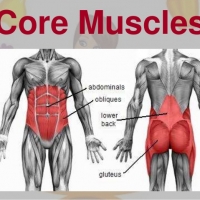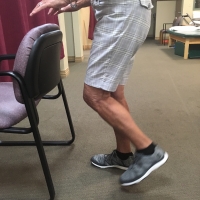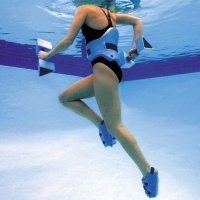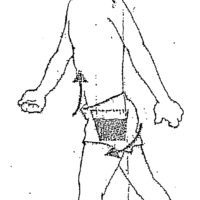 Aquatic exercises are ideal for individuals with chronic lower back pain due to the water’s properties of buoyancy and viscosity. Buoyancy offsets the loads on the spine due to gravity.
Aquatic exercises are ideal for individuals with chronic lower back pain due to the water’s properties of buoyancy and viscosity. Buoyancy offsets the loads on the spine due to gravity.
Viscosity is the resistance felt when moving through the water. Individuals can gain strength benefits from the water’s viscosity when appropriately applied. The individual can control and adjust the amount of resistance by varying speed of movement. Most activities are performed in an upright position, which is more functional .
Movement under water is resisted by the water’s viscosity: the faster you move the more resistance you get. Research has shown that doing aquatic exercises activated the trunk and pelvic muscles similar to doing land exercises. Individuals comparing land exercises and aquatic exercises reported less pain than when doing exercises on land. Individuals who are deconditioned and unable to participate in land cardio programs, such as walking or biking, can also achieve cardiorespiratory fitness in the water.
BENEFITS:
Buoyancy decreases compressive loads on the spine.
Decreased compression loads plus the water’s warmth reduces pain.
Movement is easier in the water allowing more active participation in the exercise program.
The water’s viscosity provides resistance relative to speed of movement.
PROPER PILATES POSTURE CRITICAL TO A SUCCESSFUL PROGRAM !!
Reducing pain and improving balance requires lengthening and strengthening “CORE MUSCLES.
The concept of lengthening and strengthening muscles was initiated by Joseph Pilates, who died in 1967. He based this technique on extremely sound principles. He devised his unique conditioning program after looking at various forms of yoga,ballet and martial arts. The method lengthens muscles while strengthening them, stabilizing the lumbar spine and pelvis along with controlled breathing, facilitates deep abdominal contraction. All energy for the Pilates exercises flows outward to the extremities.
The core muscles are a large group of muscles in our center, encompassing the abdomen, lower back, hips and buttocks.  These muscles stabilize the spine,pelvis and shoulders and provide a solid foundation for movement in the extremities. These muscles help control movements,transfer energy, shift body weight and move in any direction.A strong core distributes the stresses of weight bearing and protects the back. .Stabilize the Core MusclesAbdominals get all the credit for protecting the back and being the foundation of strength, but they are only a small part of what makes up the core. In fact, it is weak and unbalanced core muscles that are linked to low back pain. Weak core muscles result in a loss of the appropriate lumbar curve and a swayback posture. Stronger, balanced core muscles help maintain appropriate posture and reduce strain on the spine.Core Muscles Improve BalanceBecause the muscles of the trunk and torso stabilize the spine from the pelvis to the neck and shoulders, they allow the transfer of powerful movements of the arms and legs. All powerful movement originates from the center of the body out, not from the limbs alone. Before any powerful rapid muscle contractions can occur in the limbs, the spine must be solid and stable and the more stable the core, the more powerful the extremities can connect.Training the muscles of the core also corrects postural imbalances that can lead to injuries. The biggest benefit of core training is to develop functional fitness – that is fitness that is essential to both daily living and regular activities.
These muscles stabilize the spine,pelvis and shoulders and provide a solid foundation for movement in the extremities. These muscles help control movements,transfer energy, shift body weight and move in any direction.A strong core distributes the stresses of weight bearing and protects the back. .Stabilize the Core MusclesAbdominals get all the credit for protecting the back and being the foundation of strength, but they are only a small part of what makes up the core. In fact, it is weak and unbalanced core muscles that are linked to low back pain. Weak core muscles result in a loss of the appropriate lumbar curve and a swayback posture. Stronger, balanced core muscles help maintain appropriate posture and reduce strain on the spine.Core Muscles Improve BalanceBecause the muscles of the trunk and torso stabilize the spine from the pelvis to the neck and shoulders, they allow the transfer of powerful movements of the arms and legs. All powerful movement originates from the center of the body out, not from the limbs alone. Before any powerful rapid muscle contractions can occur in the limbs, the spine must be solid and stable and the more stable the core, the more powerful the extremities can connect.Training the muscles of the core also corrects postural imbalances that can lead to injuries. The biggest benefit of core training is to develop functional fitness – that is fitness that is essential to both daily living and regular activities.
Maintaining pilates posture throughout the execution of the exercises is of the utmost importance
- Inhale to prepare
2. Stand up straight keep the head on the shoulders, not the chest.
3. Blow out forcefully, like blowing out a candle at the same time pull the pubic bone to the ribs and drive the belly button inward towards the spine, pause and breath in slowly.
5..Visualize your pelvis as a bucket of water, pull up on the bucket and keep it level.
6… As the core muscles become stronger less effort is required to “keep your bucket level”
STANDING BALANCE EXERCISES in the water
Standing on one leg balance for 30 seconds like a crane. Maintaining Pilates Posture Alternate legs. Repeat 5 reps.

Place one heel in front of the opposite toe maintain for 30 seconds.Maintaining Pilates Posture Alternate legs repeat 5 reps. 
Walk forward/backwards placing heel of one foot in front of toe for 2-3 minutes. Maintaining Pilates Posture.
Maintaining Pilates Posture complete the “grape vine left/right for 2-3 minutes.
-
-
Deep water walking
-
is done in a pool or any other calm body of water where your feet don’t touch the bottom. During deep water walking, you mimic land-based walking movements such as walking up hills, walking sprints, and backwards walking.

Although it is not absolutely necessary, you should consider wearing a flotation vest or belt. This device keeps you afloat and holds you in a relatively stable condition in the water so that you can concentrate on your form instead of on keeping yourself afloat., you can try propping a Styrofoam weight under each arm to keep yourself afloat. Most pools have them. Stick them firmly under your arms so that they don’t interfere with your arm swing and so they keep you relatively stationary in the water.
Maintain Pilates Posture throughout the activity walking forward/backwards/sideways. As you improve gradually increase the speed , maintaining your Pilates Posture. Continue for 5 minutes, increase 3-5 minutes weekly until completing 20 minutes.
Continue the aquatic program 2-3 times weekly.
- Test standing on one leg balance test/ heel toe balance test prior to initiating the aquatic program on land. Do each test for 30 seconds. Re-test every week to see if there is improvement. Goal is to complete test without touching the floor or losing balance.
- After 2-3 weeks of aquatic exercises consider initiating low back exercises. If the pain has started to subside. Use pain scale 1-10 .
- The lowback exercises can reduce back pain, when completed slowly and on a regular basis. The exercises should not increase pain. If pain increases with exercise, ease off, if pain still increases discontinue the exercise, if no increase in pain continue the exercises. When one has leg pain the goal is to decrease the leg pain back into the low back. Decreased leg pain means the nerve irritation is subsiding. If leg pain increases discontinue the exercise and try another exercise if unsuccessful with the exercises discontinue the exercises and schedule appointment with physician to determine the cause of the pain. The goal is to select the exercises that reduce the pain. People are different, so they benefit from certain exercises, not all exercises are to be completed, be selective with pain reduction.There are 3 levels of exercises to lengthen and strengthen muscles.
- Level one are lengthening exercises.
- Level two are strengthening exercises.
- Level three advanced lengthening/strengthening exercises.
Add 2 exercises every third exercise session. Eliminate the exercises that increase pain. Start with Level 1 exercises initially, which are exercises that increase flexibility. Stay with Level 1 exercises 1-2 weeks. If pain is subsiding start Level two, which are for strengthening muscles. If pain increases with strengthening exercises, only do Level 1 exercises an additional week, then resume Level 2 exercises adding 2 exercises every third exercise session, if pain increases avoid pushing to far, back off on the exercise ,the pain you have should not increase, if it stays the same continue to exercise. Do not advance to Level 3 if you are still experiencing pain.
- Click on exercises for low back
-

